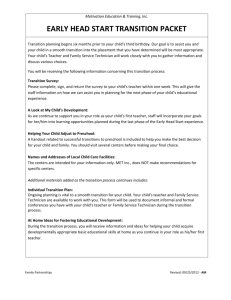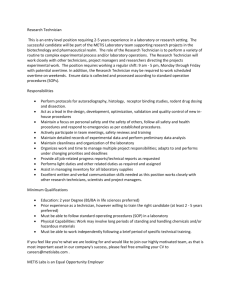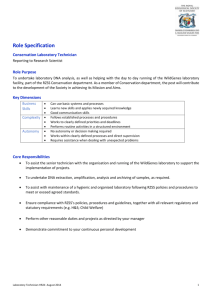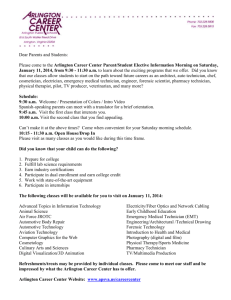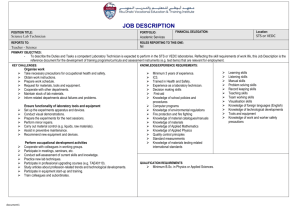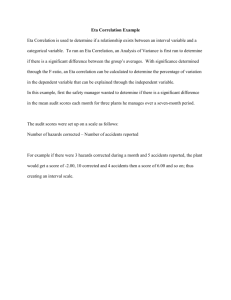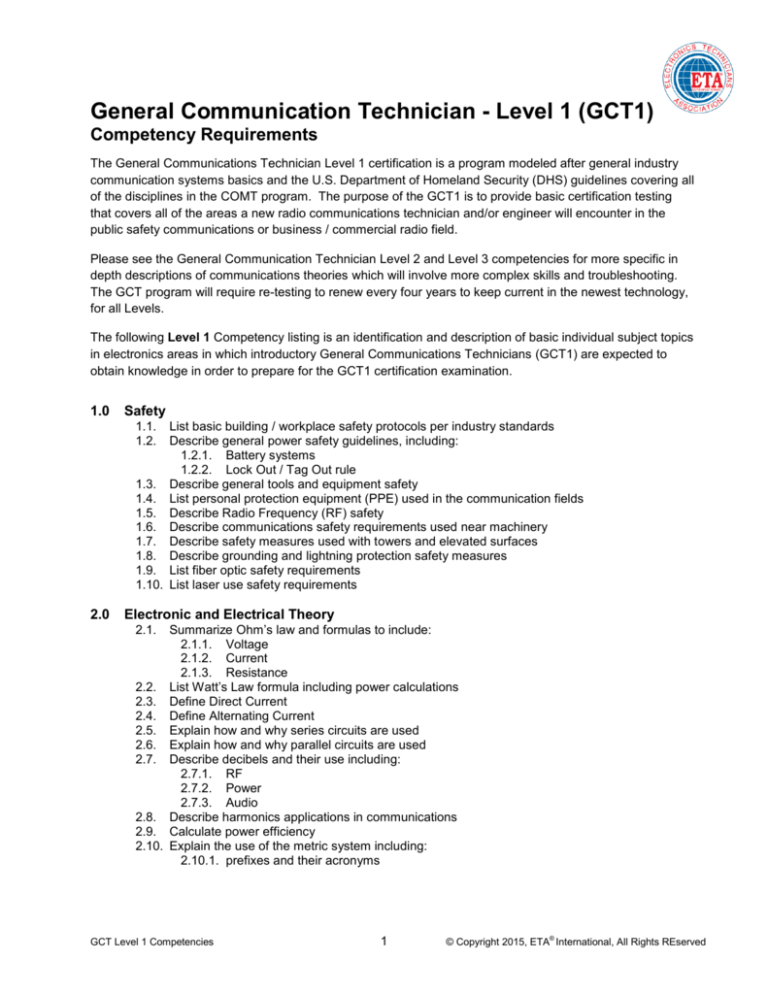
General Communication Technician - Level 1 (GCT1)
Competency Requirements
The General Communications Technician Level 1 certification is a program modeled after general industry
communication systems basics and the U.S. Department of Homeland Security (DHS) guidelines covering all
of the disciplines in the COMT program. The purpose of the GCT1 is to provide basic certification testing
that covers all of the areas a new radio communications technician and/or engineer will encounter in the
public safety communications or business / commercial radio field.
Please see the General Communication Technician Level 2 and Level 3 competencies for more specific in
depth descriptions of communications theories which will involve more complex skills and troubleshooting.
The GCT program will require re-testing to renew every four years to keep current in the newest technology,
for all Levels.
The following Level 1 Competency listing is an identification and description of basic individual subject topics
in electronics areas in which introductory General Communications Technicians (GCT1) are expected to
obtain knowledge in order to prepare for the GCT1 certification examination.
1.0
Safety
1.1.
1.2.
List basic building / workplace safety protocols per industry standards
Describe general power safety guidelines, including:
1.2.1. Battery systems
1.2.2. Lock Out / Tag Out rule
1.3. Describe general tools and equipment safety
1.4. List personal protection equipment (PPE) used in the communication fields
1.5. Describe Radio Frequency (RF) safety
1.6. Describe communications safety requirements used near machinery
1.7. Describe safety measures used with towers and elevated surfaces
1.8. Describe grounding and lightning protection safety measures
1.9. List fiber optic safety requirements
1.10. List laser use safety requirements
2.0
Electronic and Electrical Theory
2.1.
Summarize Ohm’s law and formulas to include:
2.1.1. Voltage
2.1.2. Current
2.1.3. Resistance
2.2. List Watt’s Law formula including power calculations
2.3. Define Direct Current
2.4. Define Alternating Current
2.5. Explain how and why series circuits are used
2.6. Explain how and why parallel circuits are used
2.7. Describe decibels and their use including:
2.7.1. RF
2.7.2. Power
2.7.3. Audio
2.8. Describe harmonics applications in communications
2.9. Calculate power efficiency
2.10. Explain the use of the metric system including:
2.10.1. prefixes and their acronyms
GCT Level 1 Competencies
1
© Copyright 2015, ETA® International, All Rights REserved
General Communication Technician Level 1 Knowledge Competencies
3.0
Tools and Components
3.1.
3.2.
3.3.
4.0
Connectorization
4.1.
4.2.
4.3.
4.4.
5.0
Describe the requirements for the following types of connections to include:
4.1.1. DC Power
4.1.2. AC Power
4.1.3. Telecom
4.1.4. RF
4.1.5. Signaling
List basic wiring fundamentals including:
4.2.1. Wire Sizing (Gauge)
4.2.2. Color Code
List standard connector types and functions
Describe standard connector terminations
Power Systems
5.1.
5.2.
5.3.
5.4.
5.5.
5.6.
5.7.
5.8.
5.9.
5.10.
5.11.
5.12.
5.13.
6.0
Describe hand tools used in communication fields
Describe power tools used in communication fields
Define components used in communications to include:
3.3.1. Wire
3.3.2. Resistors
3.3.3. Capacitors
3.3.4. Inductors
3.3.5. Solid State Devices
Define Voltage
Define Polarity
Describe uninterrupted power supply (UPS) systems including AC UPS systems
Describe DC power systems
Describe generators and their uses
Define battery sizing in power systems
Describe renewable energy power systems including:
5.7.1. Solar
5.7.2. Wind
Describe power distribution
Explain the use of and operation of breakers including:
5.9.1. Fuse
5.9.2. Circuit
Describe load centers usage and operation
Define a “Cutoff switch” and its use
Describe an alarm unit and its use
Define transfer boxes
Radio Frequency (RF) Fundamentals
6.1. Explain basic RF fundamental operating principles and terminology
6.2. Explain basic FCC (Federal Communications Commission) rules and regulations pertaining to
two-way communications including:
6.2.1. Licensing
6.2.2. Spectrum usage
6.3. Define RF bandwidth
6.4. Define propagation to include:
6.4.1. Line-of-Sight (LoS)
6.4.2. Groundwave
6.4.3. Skywave
6.5. List frequency spectrum band allocations to include:
6.5.1. VLF
6.5.2. LF
6.5.3. MF
6.5.4. VHF
GCT Level 1 Competencies
2
© Copyright 2015, ETA® International, All Rights Reserved
General Communication Technician Level 1 Knowledge Competencies
6.5.5.
6.5.4.1.
6.5.4.2.
6.5.4.3.
6.5.4.4.
UHF
6.5.5.1.
6.5.5.2.
6.5.5.3.
6.5.5.4.
Lowband
Mid-band
Highband
220MHz (Ham, Commercial, Positive Train Control)
380-470 MHz (Military, Federal, Ham, Commercial)
470-512 MHZ (T-band)
700 MHz (Long Term Evolution{LTE}, Commercial and Public Safety)
800 MHz (Public Safety-Emergency Responders, Cellular, Specialized
Mobile Radio{SMR or Trunking})
6.5.5.5. 900 MHz
6.5.5.6. 1.8-1.9 GHz (Broadband Personal Communications Service {PCS})
6.5.5.7. 2.1 GHz (Universal Mobile Telecommunications System {UMTS}, 3G)
6.5.5.8. 2.4 GHz (Industrial, Scientific and Medical)
6.5.6. Other Frequencies
6.6. Explain RF modulation and demodulation to include:
6.6.1. Transmitter modulation
6.6.2. Receiver demodulation
6.6.3. Receiver bandwidth must match the transmitter modulation scheme
7.0
Radio Types and Systems
7.1. Describe the following Radio Types:
7.1.1. Base
7.1.2. Mobile
7.1.3. Portable 2-way
7.1.4. Paging
7.1.4.1. Tone only
7.1.4.2. Voice
7.1.4.3. Display
7.1.5. Repeater
7.1.6. Microwave
7.1.7. Satellite
7.2. Describe the following Systems Types:
7.2.1. Simplex
7.2.2. Duplex/Half Duplex
7.2.3. Conventional
7.2.4. Microwave
7.2.5. Repeater
7.2.6. Internet Protocol (IP)
7.2.7. Wireless Network Technology (Wi-Fi) 2.4 GHz
7.3. Describe basic Radio components to include:
7.3.1. Transmitter(s)
7.3.2. Receiver(s)
7.3.3. Power Supplies
7.3.4. Audio and Control
8.0
Antennas
8.1.
8.2.
8.3.
8.4.
8.5.
8.6.
8.7.
8.8.
8.9.
8.10.
Define polarization
Describe antenna wavelength and how it is used
Define resonance
Define antenna bandwidth
Define beamwidth
Explain 3dB Points (Rule of Three)
Describe gain
Identify front-to-back ratio
Describe antenna match to include defining standing wave ratio (SWR)
Describe measurements including:
8.10.1. Power
GCT Level 1 Competencies
3
© Copyright 2015, ETA® International, All Rights Reserved
General Communication Technician Level 1 Knowledge Competencies
8.11.
8.12.
8.13.
8.14.
9.0
8.10.2. Return Loss
8.10.3. Distance-to-Fault
Describe antenna downtilt
Explain the importance of using drain holes
Describe a Balum antenna
List antenna types and azimuth to include:
8.14.1. Omnidirectional
8.14.2. Uni-Directional
8.14.3. Specialized
Transmission Lines
9.1.
9.2.
9.3.
9.4.
9.5.
9.6.
9.7.
9.8.
9.9.
9.10.
9.11.
Describe transmission line power
Explain characteristic impedance
Describe transmission line frequency
Explain line length
Describe line physical weight
Describe cable physical size/diameter (Gauge)
Describe line outer covering material
Define the importance of shielding percentage
Describe the importance of line bend radius rules
Explain line RF signal loss
List cable types used in communications
10.0 Interference
10.1. Define RF interference including:
10.1.1. natural
10.1.2. man-made
10.1.3. mitigation
10.2. Describe co-channel interference
10.3. Describe adjacent channel interference
10.4. List interference protective devices
11.0 Data Networks
11.1. Define serial data to include:
11.1.1. RS232 standard pin out
11.1.2. Universal Serial Bus (USB)
11.1.3. Data Communication Environment (DCE)
11.1.4. Data Terminal Equipment (DTE)
11.2. Describe Internet Protocol (IP) to include:
11.2.1. Wireless
11.2.2. Protocols
11.2.3. Cables
12.0 Fiber Optic Systems
12.1. Describe basic fiber optic cable fundamentals and terminology
12.2. Define fiber optic modes including:
12.2.1. Single-mode (9 µm /125) (µm = micron)
12.2.2. Multimode (50 or 62.5 µm /125)
12.3. Describe fiber optic wavelengths including:
12.3.1. 850 nanometers (nm)
12.3.2. 1310 nm
12.3.3. 1550 nm
12.4. List common fiber optic connectors
13.0
Test Equipment and Methods
13.1. Describe the use and operation of the following meters:
13.1.1. Volt Meters
13.1.2. Ammeters
GCT Level 1 Competencies
4
© Copyright 2015, ETA® International, All Rights Reserved
General Communication Technician Level 1 Knowledge Competencies
13.2.
13.3.
13.4.
13.5.
13.6.
13.7.
13.8.
13.1.3. Watt Meters
13.1.4. Optical Power meters
Define dummy load; show where and why used
Describe the value of Communication Service Monitors (CSM)
Describe the use and operation of system analyzers including:
13.4.1. Oscilloscope
13.4.2. Frequency Domain Reflectometer (FDR)
13.4.3. Time Domain Reflectometer (TDR)
13.4.4. Voltage Standing Wave Ratio (VSWR)
Describe the use and operation of audio transmission test sets to include:
13.5.1. Transmission Impairment Measurement Sets (TIMS)
Explain the use and operation of a Lineman’s handset (Butt-Sets)
Explain the use of a ground resistance tester
Describe appropriate Lock Out / Tag Out procedures
14.0 Telephony Communications
14.1. Describe telephony basics to include:
14.1.1. incumbent local exchange carrier (ILEC)
14.1.2. plain old telephone service – voice (POTS)
14.2. Describe public switched telephone networks (PSTN)
14.3. Describe private telephone networks (PTN)
14.4. Identify telephone circuit types
14.4.1. 2-wire
14.4.2. 4-wire
14.5. Define Loopback or Channel Service Unit (CSU)
15.0 Satellite Communications
15.1.
15.2.
15.3.
15.4.
15.5.
Define Low Earth Orbit (LEO) satellites
Describe why SMART was formed (Satellite Mutual Aid Radio Talk groups)
Define Broadband Global Area Network (BGAN)
Explain Global Positioning System (GPS)
Identify a satellite antenna alignment set-up
16.0 Environmental Systems
16.1.
16.2.
16.3.
16.4.
Describe fire suppression systems
Describe Heating, Ventilation, Air Conditioning (HVAC) systems affecting communications
List how lighting systems affect communications sites
Describe how vermin affect communication environments
17.0 Physical Plant / Headend and Security Systems
17.1. Describe the function of access systems / locks for a communications site
17.2. List cybersecurity systems awareness
17.3. Describe battery usage to include:
17.3.1. Types
17.3.2. Recharging
17.3.3. Proper Sizing
17.3.4. Configuration
17.3.4.1. Series
17.3.4.2. Parallel
End of General Communications Technician - Level 1 Competencies Listing
(with 17 major Categories)
GCT Level 1 Competencies
5
© Copyright 2015, ETA® International, All Rights Reserved
General Communication Technician Level 1 Knowledge Competencies
Find an ETA® Test Site
http://www.eta-i.org/testing.html
Additional Suggested Study Materials and Resources for General Communications
Technician Certification:
General Communications Technician, Level 1; Ira Wiesenfeld, P.E., CETsr, Rob Walker, LAS, PIM, Jay
Thompson, CETsr, A.J. Wiesenfeld, BSEE, LAS; ISBN 978-0-9915913-5-0; Self Published; 2015;
®
softcover. Contact ETA International at 800-288-3824 or eta@eta-i.org
Modern Electronic Communication, 9E; Jeff Beasley, Gary Miller, ISBN 978-0-13225113-6; Prentice
Hall; 2007; hardcover.
Wiring for Wireless Sites; Ira Wiesenfeld, P.E., CETsr, ISBN 978-1-40181037-5; Prompt; 2002;
®
softcover. Contact ETA International at 800-288-3824 or eta@eta-i.org
http://www.dhs.gov/communications-technician-training
ETA certification programs are accredited through the ICAC,
complying with the ISO/IEC 17024 standard.
GCT Level 1 Competencies
6
© Copyright 2015, ETA® International, All Rights Reserved


